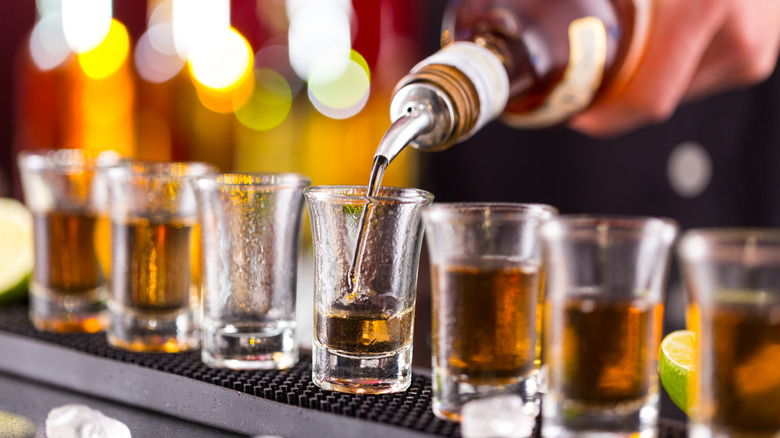Why A Shot Of Liquor Is Actually Called A 'Shot'
If you've ever been with a group of friends and had someone call for a round of shots, it's entirely possible that the first question that comes to mind is what you're going to be drinking: Will it be sweet like a lemon drop, or tangy like the notorious pickleback shot? Your next question likely isn't why it is called a shot. You might just assume you already know. And if you think you know thanks to a bit of social media wisdom that's been floating around — not so fast.
The oft-repeated bit of trivia is the claim that the term dates back to the American West when bullets cost roughly the same as a drink. That led to the practice of paying for a drink with a bullet — or a shot — and while that's a neat story, that's all it is. There are a few problems with this claim, starting with the fact that bullets and alcohol didn't cost the same. Alcohol was much more expensive. There's also the fact that the term was in use long before the heyday of the American West.
The Reverend Oliver Heywood was a Puritan preacher, and in "His Autobiography, Diaries, Anecdote, and Event Books" (via the Internet Archive), he wrote of attending a funeral in 1676. Afterward, he noted that he joined a group to observe "their vain way of drinking shots, I saw some lay at it busily." It's believed to be the first time the term appeared in print, but that doesn't answer where it came from.
The term likely came together from a few different places
Today, you'll be the star of any holiday party with egg nog Jell-O shots, but head back to 15th-century England, and you'll learn that "shot" has a different alcohol-related meaning. Initially, it referred to the portion of a bar tab that each group member was responsible for paying. Fast forward through history a bit, and by the 1700s, the term had come to mean both a portion of the bar bill and a portion of ale.
No one's quite sure how that turned into a measure of alcohol, but a possible connection comes when you consider how a shot is consumed. You don't sip it; you drink it in one go. You're throwing it back in one shot, as it were, from a shot glass. Although it wasn't officially called a shot glass until much later, this theory suggests that it's not the drinking part it's referring to, but the sound of a group of people slamming thick, heavy glasses down on a bar top. It was likened to the sound of firing muskets, and that was eventually shortened to shots (which could also circle back to explain how the bullet theory came into being as well).
There's another interesting footnote to this: It wasn't until 1928 that the term was connected to a specific measurement of alcohol. And that's not the same everywhere: A standard shot in the U.S. is between 30 and 44 milliliters, but go to Slovenia, Poland, Israel, Romania, or Bulgaria, and that jumps to 50 milliliters. In some countries — like South Africa — it's only 25 milliliters, and in Germany? 20 milliliters.
The shot glass is a surprisingly recent addition to bar terminology
It makes sense that shot glasses have also been around for a while, right? Not exactly. According to the Oxford English Dictionary's findings, the word — specifically rendered as "shot-glass" — didn't show up until 1955. It was coined by Arthur Miller, the playwright most famous for works including "Death of a Salesman" and "The Crucible" (and for being Mr. Marilyn Monroe).
The glasses themselves had been around for much longer. Copper shot glasses (similar to the copper mugs that have long been used for Moscow Mules) were particularly popular in the 18th century, and they were used on ships to portion out rum to sailors. They later became popular in bars and slowly transitioned to glass. Advances in refrigeration meant that copper glasses were no longer needed to help insulate drinks to keep them cold, and advances in glass technology meant that they were much more durable than they had previously been.
Interestingly, there's another odd connection here, and it's often mentioned as one potential source for the terminology of the "shot" — although it seems pretty unrelated. In the mid-1800s, a German chemist named Otto Schott was behind the development of dozens of new types of glass, including glass that was heat-resistant, more durable, and designed to stand up to the rigors of scientific research ... and, to being knocked around on a bar. There's a theory that "shot glass" came from his name, but given that the term didn't show up until 20 years after his death, that seems unlikely.


